Simulation Test of The Aerodynamic Environment of A Missile-Borne Pulsed Laser Forward Detection System at High Flight Speed
Abstract
:1. Introduction
- (1)
- To address the shortcomings of the conventional fixed-step ray tracing method, a new ray tracing method with adaptive step size adjustment is proposed.
- (2)
- An aerodynamic environment simulation test of a missile-borne pulsed laser forward detection system at high flight speed is carried out. The aerodynamic environment of a munition flying at high speed is simulated by an intermittent transonic and supersonic wind tunnel to obtain the schlieren data of the flow field surrounding the missile-borne pulsed laser forward detection system at various Mach numbers. The schlieren data are compared with the simulation results for the flow field.
- (3)
- The test equipment (such as the transonic wind tunnel) is used to simulate the flow field environment of the missile-borne pulsed laser forward detection system at a high flight speed. The aerodynamic characteristics of the model and the variation patterns of the pulsed laser echo waveform under different conditions are studied and compared with the simulation results of Reference [28]. The systematic and random errors of test data with Mach number show the same overall trends as those of the simulation data, which verifies the effectiveness of the semi-analytical method-based pulsed laser echo model.
2. Response Model
2.1. Equivalent Response Model of Missile-Fuze System
2.2. Improved Ray Tracing Method Based on Adaptive Step Size Adjustment
- (1)
- is set to not exceed the average geometric size of the local grid cells. The reason is that considering the turbulent phenomenon of sharp changes in the density of shock waves in the shock-wave flow field, the accuracy of computational fluid dynamics (CFD) in capturing shock waves is generally two to three grid cells. Although the refractive index changes greatly in these grids, the change in the refractive index in the local area before and after the shock wave may be very gentle; if is set too large, it may cross the shock wave structure and cause a large error in the result.
- (2)
- The minimum tracing step size is 0.05 , which is the optimal value determined by multiple numerical tests.
3. Test Model and Test Method
3.1. Test Equipment
3.2. Measurement of Aerodynamic Characteristics of the Supersonic Flow Field
- (1)
- Fix the test model on the bracket, adjust the position of the bracket so that the model is in the center of the schlieren observation window, and then fix the model.
- (2)
- Configure a 250 mm hybrid schlieren system to observe whether the display effect is normal under static conditions.
- (3)
- Turn on the air inlet switch of the wind tunnel, release the high-pressure gas, and record the data at the corresponding Mach number after the flow field is stable.
- (4)
- Turn off the air inlet switch, and check whether the test model is in good condition after the airflow disappears and whether the optical lens is loose, falling off, or deformed.
- (5)
- Replace the nozzle with a nozzle with a different Mach number, repeat the above steps, and finally obtain the schlieren data of the flow field under 2–4 Ma.
- (6)
- After the test, turn off the electrical equipment and record and process all test data.
3.3. Echo and Ranging Data Collection by the Missile-Borne Pulsed Laser Forward Detection System
- (1)
- Fix the test model and the reflector on the brackets, install the two brackets on the wall surface and the strut of the wind tunnel test section, respectively, and adjust the distance between the laser emitting module and the reflector to 1.5 m.
- (2)
- Connect the test model to the external power supply and the data acquisition system through wires, turn on the power to observe whether the emitted laser spot is located in the center of the reflector, and record the laser echo signal and ranging data in static conditions.
- (3)
- Turn on the air inlet switch of the wind tunnel, release the high-pressure gas, and record the echo signal and ranging data at the corresponding Mach number after the flow field is stable.
- (4)
- Turn off the air inlet switch and check whether the test model is in good condition after the airflow disappears and whether the wires are broken or deformed.
- (5)
- Replace the nozzles with different Mach numbers, repeat the above steps, and finally obtain the laser echo signals and ranging data at Mach 2, 3, and 4.
- (6)
- After the test, turn off the electrical equipment and record and process all test data.
4. Analysis of Test Results
4.1. Visualized Schlieren Analysis of the Supersonic Flow Field
4.2. Analysis of the Detected Echo
5. Conclusions
- (1)
- A new ray tracing method with adaptive step size adjustment is proposed. By setting a step size adjustment piecewise function, the gradient change of the refractive index inside the grid cells can be captured, and the step size in the ray tracing process can be adaptively controlled. The results show that although the error of ray tracing is not sensitive to the tracing step size in the same grid cell, the adaptive step adjustment ray tracing method can significantly improve the tracing efficiency.
- (2)
- In a simulation test of the aerodynamic environment of the missile-borne pulsed laser forward detection system at a high flight speed, the aerodynamic environment of the munition at high flight speed is simulated by the intermittent transonic and supersonic wind tunnel to obtain the schlieren data of the flow field surrounding the missile-borne pulsed laser forward detection system at various Mach numbers. The schlieren data are compared with the simulation results of the flow field. The results show that the two match well and present similar shock wave structures, which verifies the correctness and effectiveness of the flow field simulation model.
- (3)
- The echo waveform measurement of the missile-borne pulsed laser forward detection system is completed. The laser echo signals at different Mach numbers are sampled, and the test echo data are compared with the simulated echo data. The results show that the peak value of the test echo decreases gradually with increasing Mach numbers and drops by 0.281 V from 0 to 4 Ma. The test echo waveforms are in good agreement with the simulated echo waveforms, and the relative error between the peak values of the test and simulated echo waveforms at each Mach number does not exceed 20%. In addition, the correlation coefficients of the test and simulated echo waveforms all exceed 0.7, indicating high correlations between the two.
Author Contributions
Funding
Institutional Review Board Statement
Informed Consent Statement
Data Availability Statement
Conflicts of Interest
References
- Zhang, B.; He, L.; Yi, S.; Ding, H. Multi-resolution analysis of aero-optical effects in a supersonic turbulent boundary layer. Appl. Opt. 2021, 60, 2242–2251. [Google Scholar] [CrossRef]
- Hua, T.; Dai, K.; Zhang, X.; Yao, Z.; Wang, H.; Xie, K.; Feng, T.; Zhang, H. Optimal VMD-based signal denoising for laser radar via Hausdorff distance and wavelet transform. IEEE Access 2019, 7, 167997–168010. [Google Scholar] [CrossRef]
- Wang, Z.; He, G.; Du, W.; Zhou, J.; Han, X.; Wang, J.; He, H.; Guo, X.; Wang, J.; Kou, Y. Application of parameter optimized variational mode decomposition method in fault diagnosis of gearbox. IEEE Access 2019, 7, 44871–44882. [Google Scholar] [CrossRef]
- Wyckham, C.M.; Smits, A.J. Aero-optic distortion in transonic and hypersonic turbulent boundary layers. AIAA J. 2009, 47, 2158–2168. [Google Scholar] [CrossRef]
- Akondi, V.; Dubra, A. Shack-Hartmann wavefront sensor optical dynamic range. Opt. Express 2021, 29, 8417–8429. [Google Scholar] [CrossRef]
- Gordeyev, S.; Jumper, E.; Hayden, T.E. Aero-Optical Effects of Supersonic Boundary Layers. AIAA J. 2015, 50, 682–690. [Google Scholar] [CrossRef]
- Smith, A.; Gordeyev, S.; Jumper, E. Aperture effects on aero-optical distortions caused by subsonic boundary layers. In Proceedings of the 43rd AIAA Plasmadynamics and Lasers Conference, New Orleans, LA, USA, 25–28 June 2012; AIAA: New Orleans, LA, USA, 2012; p. 2986. [Google Scholar]
- Trolinger, J.; L’Esperance, D.; Kim, J.H.; Kastner, J.; Lempert, W.; Samimy, M. Optical diagnostics for quantifying flow control effects on aero optical wavefront degradation. In Proceedings of the 36th AIAA Plasmadynamics and Lasers Conference, Toronto, ON, Canada, 6–9 June 2005; AIAA: Toronto, ON, Canada, 2005; p. 4658. [Google Scholar]
- Ding, H.; Yi, S.; Zhao, X.; Xiong, H.; Ouyang, T. Experimental Investigation on Aero-Optical Mitigation of Hypersonic Optical Dome Using Microvortex Generators. AIAA J. 2019, 57, 1–6. [Google Scholar] [CrossRef]
- Gao, Q.; Yi, S.H.; Jiang, Z.F. Universal form of the power spectrum of the aero-optical aberration caused by the supersonic turbulent boundary layer. Chin. Phys. B 2014, 23, 104201. [Google Scholar] [CrossRef]
- Lee, S.; Lee, B.J.; Jeung, I.S. Wavefront distortion due to the shock wave and boundary layer in the supersonic flow over a compression ramp. Aerosp. Sci. Technol. 2021, 110, 106489. [Google Scholar] [CrossRef]
- Hui, W.; Chen, S.; Zhang, W.; Dang, F.; Ju, L.; Xu, X.; Fan, Z. Evaluating imaging quality of optical dome affected by aero-optical transmission effect and aero-thermal radiation effect. Opt. Express 2020, 28, 6172–6187. [Google Scholar] [CrossRef] [PubMed]
- Shirley, L.G.; Hallerman, G.R. Applications of Tunable Lasers to Laser Radar and 3D Imaging; Massachusetts Institute of Technology, Lincoln Laboratory: Lexington, MA, USA, 1996. [Google Scholar]
- Der, S.; Redman, B.; Chellappa, R. Simulation of error in optical radar range measurements. Appl. Opt. 1997, 36, 6869. [Google Scholar] [CrossRef] [PubMed]
- Steinvall, O. Influence of laser radar sensor parameters on range-measurement and shape-fitting uncertainties. Opt. Eng. 2007, 46, 106201. [Google Scholar] [CrossRef]
- Steinvall, O. Effects of target shape and reflection on laser radar cross sections. Appl. Opt. 2000, 39, 4381–4391. [Google Scholar] [CrossRef] [PubMed]
- Blanquer, E. LADAR Proximity Fuze-System Study. Master’s Thesis, Royal Institute of Technology, Stockholm, Sweden, 2007. [Google Scholar]
- Hao, Q.; Cheng, Y.; Cao, J.; Zhang, F.; Zhang, X.; Yu, H. Analytical and numerical approaches to study echo laser pulse profile affected by target and atmospheric turbulence. Opt. Express 2016, 24, 25026–25042. [Google Scholar] [CrossRef] [PubMed]
- Amann, M.C.; Bosch, T.M.; Lescure, M.; Myllylae, R.A.; Rioux, M. Laser ranging: A critical review of unusual techniques for distance measurement. Opt. Eng. 2001, 40, 10–19. [Google Scholar]
- Steinvall, O.; Chevalier, T. Range accuracy and resolution for laser radars. In Proceedings of the Electro-Optical Remote Sensing. International Society for Optics and Photonics, Bruges, Belgium, 26–28 September 2005; SPIE: Bruges, Belgium, 2005; Volume 5988, p. 598808. [Google Scholar]
- Oh, M.S.; Kong, H.J.; Kim, T.H.; Hong, K.H.; Kim, B.W. Reduction of range walk error in direct detection laser radar using a Geiger mode avalanche photodiode. Opt. Commun. 2010, 283, 304–308. [Google Scholar] [CrossRef]
- Johnson, S.E. Effect of target surface orientation on the range precision of laser detection and ranging systems. J. Appl. Remote Sens. 2009, 3, 2527–2532. [Google Scholar] [CrossRef]
- Zhou, X.; Sun, J.; Jiang, P.; Liu, D.; Wang, Q. Influence investigation on ranging performance for range-gated Geiger-mode avalanche photodiode ladar. Appl. Opt. 2018, 57, 2667. [Google Scholar] [CrossRef]
- Luo, H.; Ouyang, Z.; Liu, Q.; Lu, Z.; Li, B. Improved cumulative probabilities and range accuracy of a pulsed Geiger-mode avalanche photodiode laser ranging system with turbulence effects. Appl. Opt. 2017, 56, 8216–8223. [Google Scholar] [CrossRef]
- Banakh, V.A.; Sukharev, A.A.; Falits, A.V. Optical beam distortions induced by a shock wave. Appl. Opt. 2015, 54, 2023. [Google Scholar] [CrossRef] [PubMed]
- Bathel, B.F.; Weisberger, J.M. Compact, self-aligned focusing schlieren system. Opt. Lett. 2021, 46, 3328–3331. [Google Scholar] [CrossRef]
- Xu, Y.; Pan, X.; Sun, M.; Liu, W.; Liu, C.; Zhu, J. Single-shot ultrafast multiplexed coherent diffraction imaging. Photonics Res. 2022, 10, 1937–1946. [Google Scholar] [CrossRef]
- Hua, T.; Liu, T.; Dai, K.; Yao, Z.; Zhang, X.; Zhang, H. Numerical investigation on the ranging performance of forward pulsed laser radar affected by shock waves. Opt. Express 2022, 30, 20909–20926. [Google Scholar] [CrossRef]
- Wang, L.; Sun, L.; Gong, R.; Zhu, D. Error Analysis in SAR Imaging Due to Fluctuation of Atmospheric Refractive Index. J. Electron. Inf. Technol. 2021, 43, 665–673. [Google Scholar]
- Xu, L.; Cai, Y. Influence of altitude on aero-optic imaging deviation. Appl. Opt. 2011, 50, 2949–2957. [Google Scholar] [CrossRef]
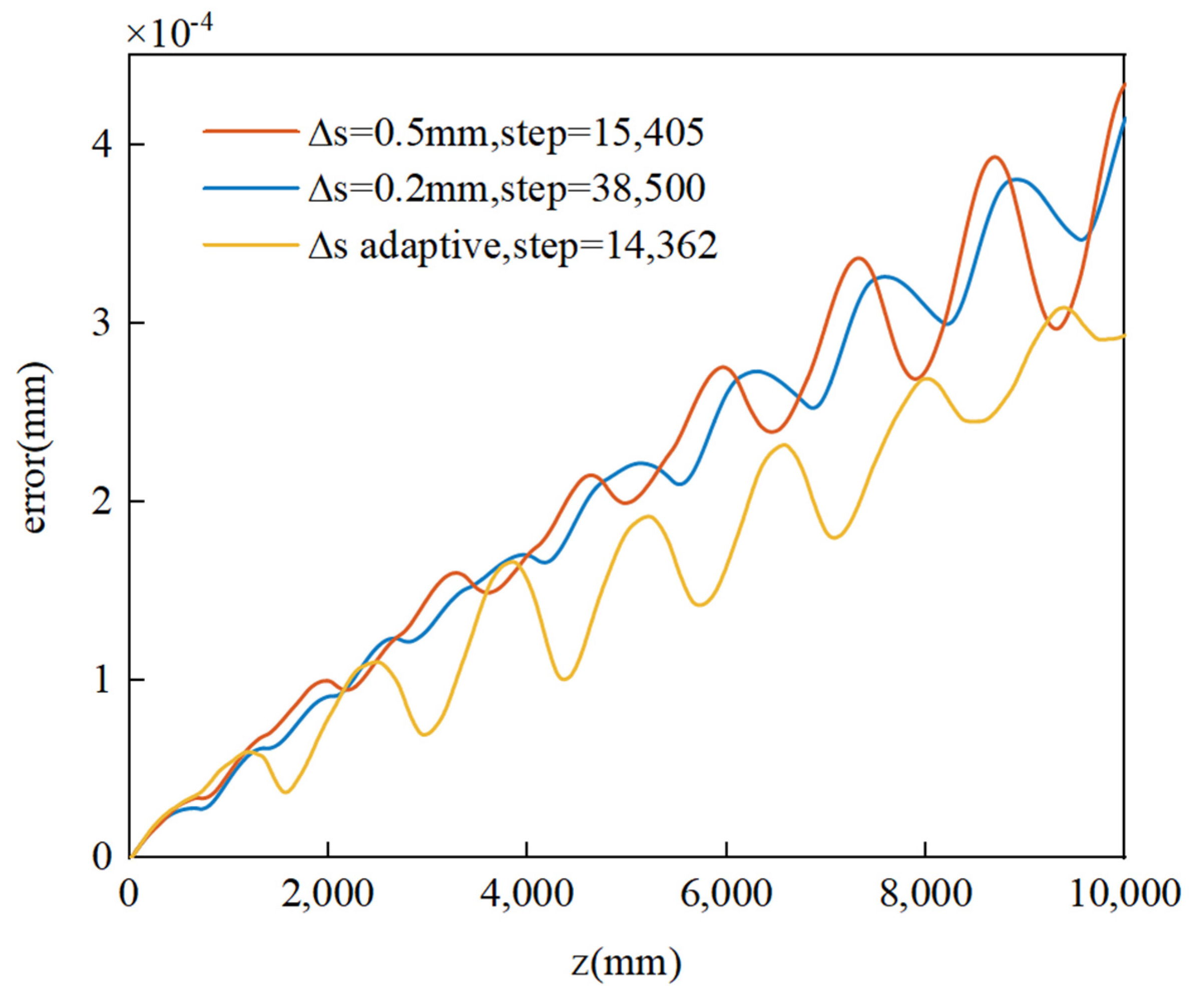
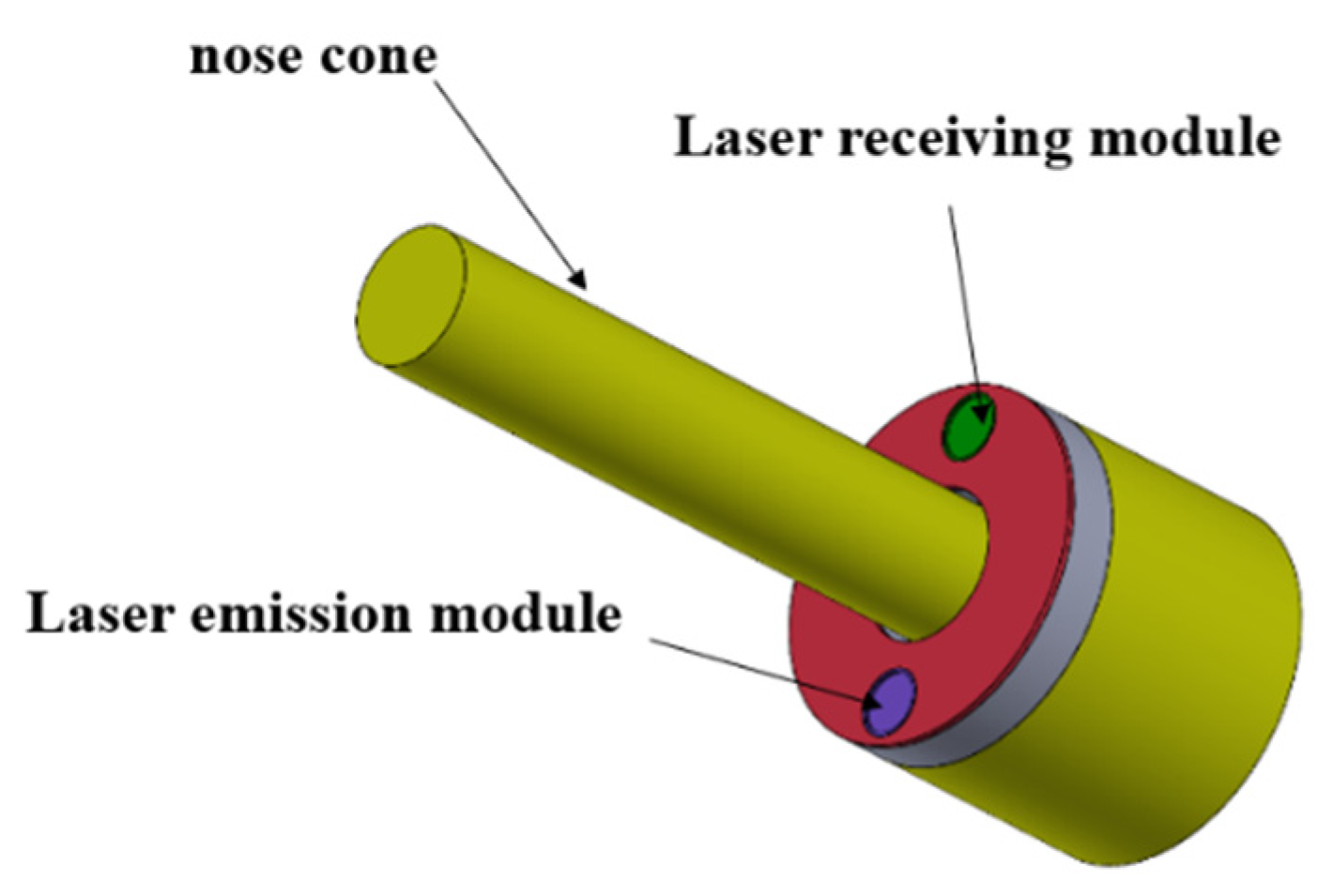

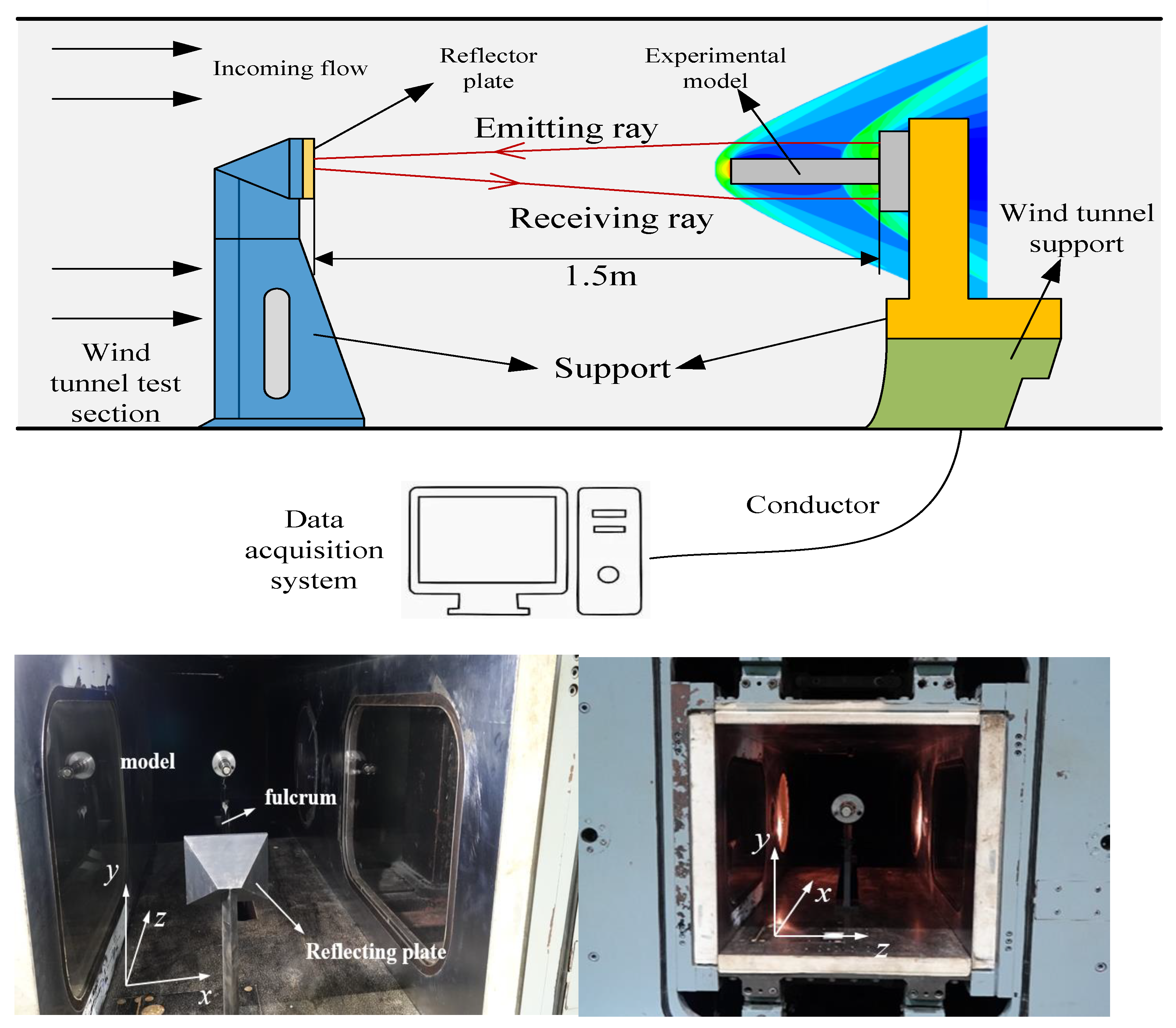

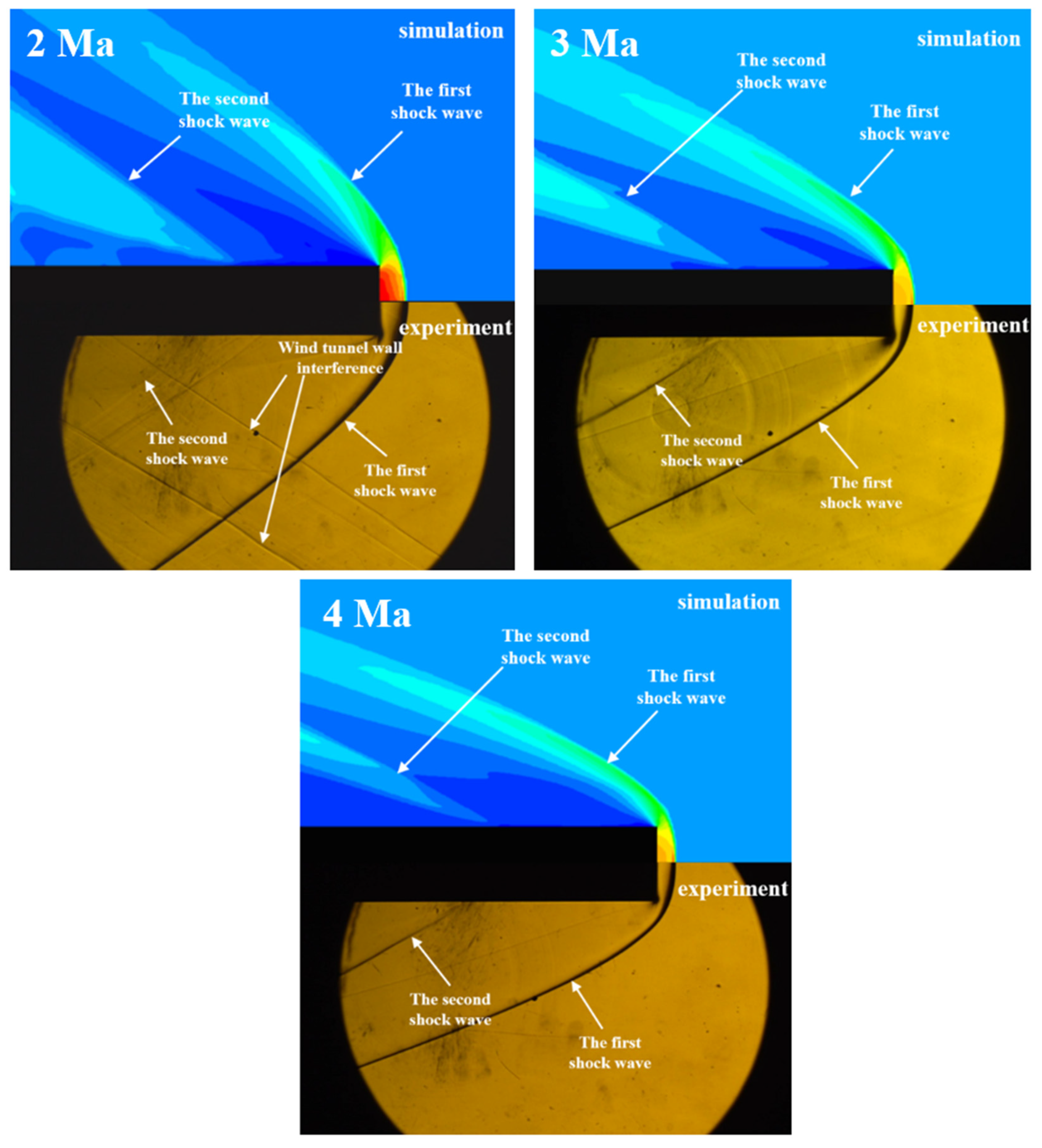
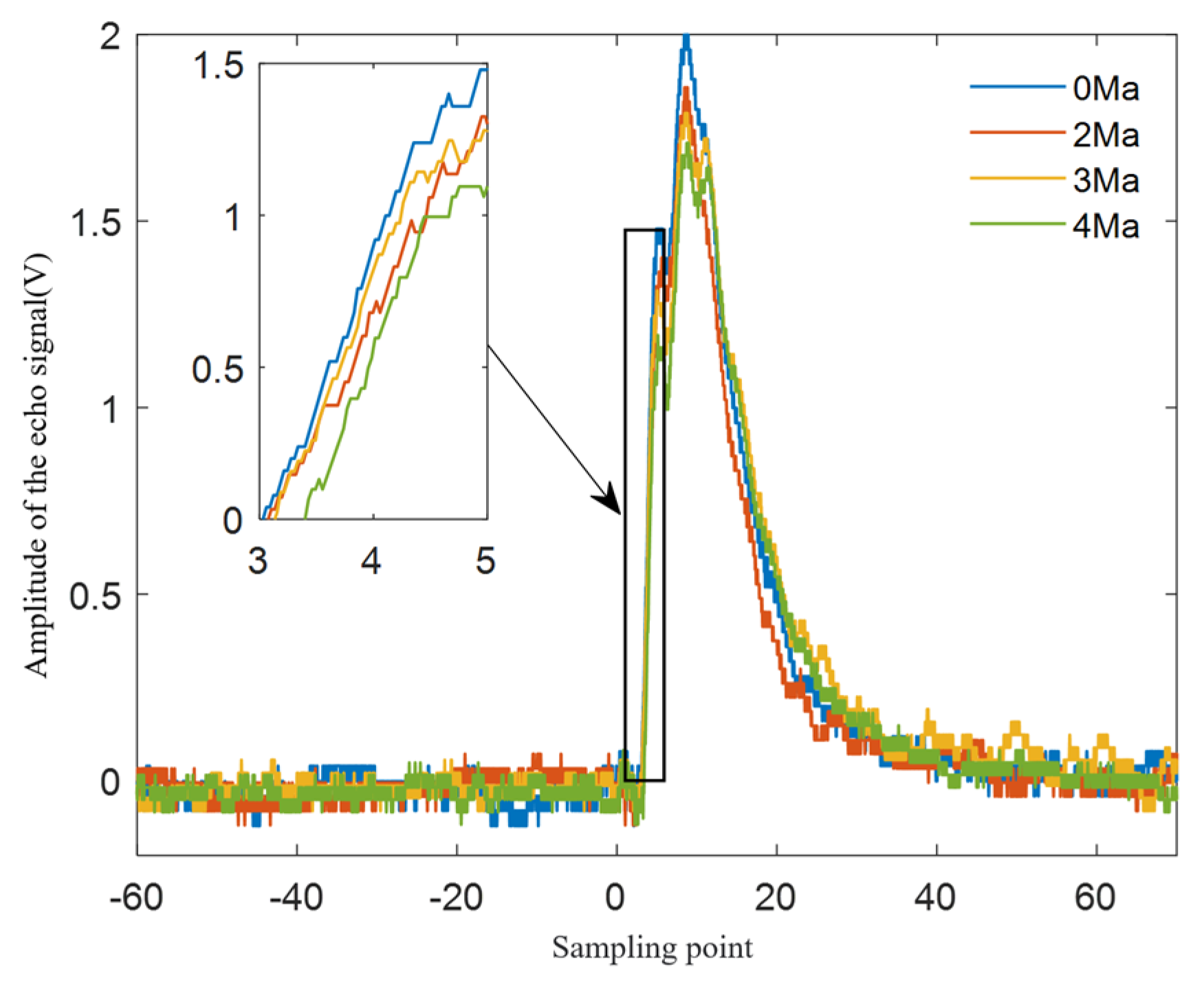

| Parameter | Numerical Value |
|---|---|
| Mach number | 0.4~4.5 |
| Attack angle | −1°~49° |
| Angle of sideslip | −7°, −5°, −3°, −1°, 0°, 1°, 2°, 3°, 5° |
| Stagnation pressure | (0.95~7.2) × 105 Pa |
| Dynamic pressure | (0.056~0.69) × 105 Pa |
| Reynolds number (1/m) | (9.87~28.7) × 106 |
| Total temperature | 280~290 K |
| Parameter | Numerical Value |
|---|---|
| Mach number | 2.0, 3.0, 4.0 |
| Attack angle (°) | 0 |
| Total temperature (K) | 288 |
| Total pressure (MPa) | 0.19, 0.36, 0.63 |
| Density () | 0.51, 0.33, 0.20 |
| Time (s) | >10 s |
| Mach Number | 0 Ma | 2 Ma | 3 Ma | 4 Ma |
| Test echo peak voltage (V) | 2.019 | 1.878 | 1.809 | 1.738 |
| Mach Number | 0 Ma | 2 Ma | 3 Ma | 4 Ma |
| Peak relative error | 1.28% | 8.51% | 13.87% | 18.65% |
| Correlation Coefficient | Degree of Correlation |
|---|---|
| 0.00~±0.30 | Micro correlation |
| ±0.30~±0.50 | Real correlation |
| ±0.50~±0.80 | Significant correlation |
| ±0.80~±1.00 | Highly correlated |
| Mach Number | 0 Ma | 2 Ma | 3 Ma | 4 Ma |
| Correlation coefficient | 0.7981 | 0.7745 | 0.7561 | 0.7432 |
Disclaimer/Publisher’s Note: The statements, opinions and data contained in all publications are solely those of the individual author(s) and contributor(s) and not of MDPI and/or the editor(s). MDPI and/or the editor(s) disclaim responsibility for any injury to people or property resulting from any ideas, methods, instructions or products referred to in the content. |
© 2023 by the authors. Licensee MDPI, Basel, Switzerland. This article is an open access article distributed under the terms and conditions of the Creative Commons Attribution (CC BY) license (https://creativecommons.org/licenses/by/4.0/).
Share and Cite
Liu, P.; Li, J.; Hua, T.; Zhang, H. Simulation Test of The Aerodynamic Environment of A Missile-Borne Pulsed Laser Forward Detection System at High Flight Speed. Photonics 2023, 10, 1363. https://doi.org/10.3390/photonics10121363
Liu P, Li J, Hua T, Zhang H. Simulation Test of The Aerodynamic Environment of A Missile-Borne Pulsed Laser Forward Detection System at High Flight Speed. Photonics. 2023; 10(12):1363. https://doi.org/10.3390/photonics10121363
Chicago/Turabian StyleLiu, Peng, Jian Li, Tuan Hua, and He Zhang. 2023. "Simulation Test of The Aerodynamic Environment of A Missile-Borne Pulsed Laser Forward Detection System at High Flight Speed" Photonics 10, no. 12: 1363. https://doi.org/10.3390/photonics10121363
APA StyleLiu, P., Li, J., Hua, T., & Zhang, H. (2023). Simulation Test of The Aerodynamic Environment of A Missile-Borne Pulsed Laser Forward Detection System at High Flight Speed. Photonics, 10(12), 1363. https://doi.org/10.3390/photonics10121363




